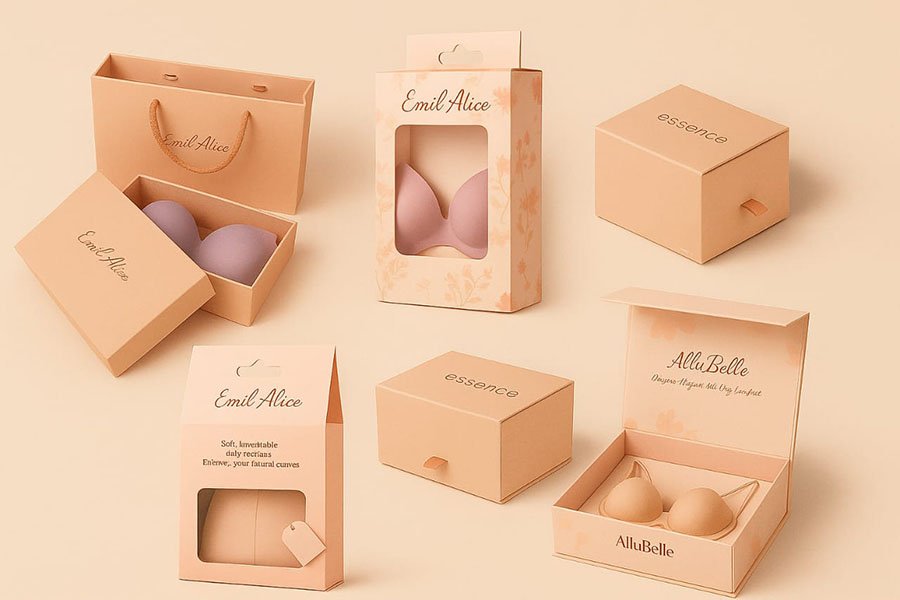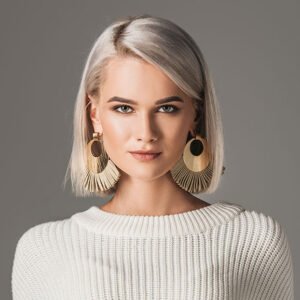
Imagine this: someone orders your fancy bra, waits for that special delivery moment, rips open the box and finds it squished inside some sad, crinkly plastic bag with a half-hearted logo sticker. Luxury vibes? Not so much. More like “I bought this off a bargain site at 2am.”
In the world of lingerie, bra packaging is more than just “the box it comes in.” It’s your silent salesperson, your brand ambassador, and — increasingly — your statement about values like sustainability. In this article, we’ll dive into bra boxes, custom bra boxes, apparel packaging, and lingerie packaging — what works, what’s trending, and how to do it right.
Why Packaging Matters (Beyond Protection)
First impressions count
Most people don’t get their first taste of your brand from some fancy Instagram ad or a slick website. It’s the box or the bag they rip open first. If your packaging pops, people get hyped before they even see what’s inside. It’s like, “Did I just buy something special?” Even the price starts to make more sense if it looks the part.
In a recent study, researchers used deep learning to analyze how the placement of a brand logo and visual saliency influence attention on packaging. The takeaway? Even subtle design decisions — how big the logo is, where it is placed — matter.
Protection + presentation
Lingerie (especially bras) includes underwires, clasps, delicate lace, and fabrics. Packaging has to balance two roles:
- Protection— ensuring the garment arrives intact (no crushed cups, torn straps, etc.).
- Presentation— making the unboxing experience delightful (folding, layering, tissue, etc.).
A structural design that folds, cushions, or locks the bra in place is critical.
Sustainability is no longer optional
People are getting way more fired up about the environment these days. Like, it’s not just a trend—people actually want brands to stop trashing the planet. Shorr’s report says 9 out of 10 shoppers are more likely to buy something if it comes wrapped in eco-friendly stuff.
But here’s the kicker: the clothing industry is still a total mess when it comes to plastic. Not just the clothes, but all the packaging junk too. Some big assessment recently dropped the bomb that in 2019 alone, the whole apparel world was responsible for 8.3 million tons of plastic just leaking out into the wild. That is like 14% of the world’s plastic pollution that year.
So, if you’re investing in custom bra boxes or lingerie packaging, you also have an opportunity (and perhaps responsibility) to choose wisely.
Common Types of Bra & Lingerie Packaging
Here’s a rundown of the most common packaging formats, along with their pros, cons, and suitability.
| Packaging Type | Description | Pros | Cons / Challenges | Best For |
|---|---|---|---|---|
| Foldable / Collapsible Boxes | Cardboard or paperboard boxes that can be flattened for shipping | Cost-effective transport, customizable, sturdy when assembled | Needs support structure, may require manual assembly | Standard bras, e-commerce |
| Rigid / Drawer / Lid Boxes | High-end boxes that don’t fold | Luxurious feel, strong protection, premium positioning | Higher cost, more storage space in transit | Luxury lingerie, gift sets |
| Tube Packaging | Cylindrical tubes (paperboard, coated) | Unique look, good for flexibility, protective | Not always space-efficient, more expensive | Specialty or limited-edition bras |
| Poly bags / Pouches / Zipper bags | Clear or printed plastic or film (e.g. OPP, PP, PE) | Very low cost, lightweight, customizable | Less protection, perception of lower value, plastic waste | Lining inside a box or for individual pieces |
| Non-woven cloth pouches / fabric sleeves | Soft bags made of non-woven or cotton | Reusable, premium feel, eco alternatives | More costly, less rigid protection | Sleepwear, lingerie sets, soft bras |
From “Top 10 Favored Underwear Packaging Styles,” some trendy picks are foldable paper bags, transparent plastic boxes, and tubes — each combining utility and aesthetics.
Another source, Jingsourcing’s “10 Ways to Customize Underwear Packagings,” differentiates the “packaging bag” vs. “packaging box” approaches.
Custom Bra Boxes: Making It Uniquely Yours
When you hear “custom bra boxes,” think personalization, branding, and storytelling — but also structure and function.
Key components in custom packaging
- Material & thickness:From kraft to rigid board, choose something that protects without being wasteful.
- Finish & print options:Spot UV, embossing, foil stamping — these add elegance.
- Windows / die cuts:A transparent cutout can tease the product inside (be careful with fragility).
- Inserts & support:Foam, molded pulp, paper folds — choose internal structure smartly.
- Sustainability elements:Use recycled stock, water-based inks, or compostable liners.
A custom bra box that is well-engineered can reduce damage claims, lower returns, and deliver a branded unboxing experience that fans will share on social media.
Some luxury lingerie packaging companies offer bespoke boxes with premium finishes, window cutouts, and custom inserts.
Creative custom touches (ideas)
- A small “thank you” card or sticker inside
- A fold-out mini lookbook or QR code to styling videos
- Brand messaging about sustainability or care instructions
- Hidden compartments (e.g., for spare straps)
- A dedicated envelope for returns or care sheet
The goal: make the customer feel they’re opening something special — not just another order.
Apparel Packaging & The Lingerie Niche
Apparel packaging covers everything from shirts and jeans to intimate wear. But lingerie has its own nuances:
- Fragility & shape retention:Bras have cups and wires; you need structure not just foldability.
- Hygiene & perception:Customers may value sealed pouches or tamper-proof packaging.
- Emotional & intimate branding:Packaging can set the tone — sensual, fun, bold, minimalist.
In underwear and lingerie, brands are using lingerie packaging that moves them out of the “commodity” space — into something aspirational and shareable.
In fact, it is noted that customized boxes outperform generic sleeves or bags in terms of shelf presence and unboxing delight.
Many lingerie brands are shifting away from petroleum-based plastics toward cardboard boxes, compostable film, or reusable cloth pouches.
Trends & Innovations in Bra / Lingerie Packaging
1. Biobased & compostable materials
Sustainable packaging research highlights tension between innovation and scalability.
Still, many fashion brands are switching to compostable films or recycled kraft for lingerie packaging.
2. Reusable & returnable systems
Closed-loop box reuse (i.e. reusing boxes multiple times) is gaining traction in supply chain design.
Brands may invite customers to return the outer box for reuse or recycling, or design multi-use packaging.
3. Minimalism & “naked packaging”
Less is more. Some brands drop the outer box and go for elegantly designed pouches or minimal sleeves to cut waste and cost.
4. Smarter design for efficiency
Designing boxes that nest or fold neatly can reduce shipping costs. Avoiding overpackaging is key — there’s waste in excess space or padding.
5. Transparent sustainability storytelling
Communicating clearly (not greenwashing) is essential. A study investigating how apparel companies communicate sustainable packaging found that message framing (benefits, impact, transparency) plays a big role in consumer reception.
Brands are adding icons or short statements like “100% recycled paper,” “compostable film,” or “return for reuse” on their bras packaging.
The Unboxing Experience: Tips to Delight
- Layer thoughtfully— smooth tissue paper, a protective sleeve, and then the final box.
- Ensure tight, clean folds— loose packaging feels cheap.
- Plan for cushioning / support— foam inserts or molded pulp to cradle the bra.
- Add a personalized note or care card— that personal touch goes a long way.
- Make returns easy— include return label pouch or instructions.
- Optimize for shipping— your packaging should survive the journey, ideally in outer mailers, without damage.
Consumer Behavior Insights: What Shifts Are Happening?
- Eco preferences drive purchase decisions: 54% of surveyed consumerssaid they deliberately chose sustainable packaging in the past six months.
- Willingness to pay more: Many consumers are comfortable paying a premium for eco-packaging.
- Switching brands: Some consumers change brands when packaging doesn’t align with their values.
- Transparency matters: Ambiguous claims backfire — brands need clear, truthful communication.
- Viewed perceptions: Stunning packaging often leads to more social media shares and stronger brand recall.
Sample Workflow: From Brief to Delivery
Here’s a simplified flow for designing your own custom bra boxes / lingerie packaging:
- Define goals & constraints— budget, shipping limits, sustainability goals.
- Choose format(s)— collapsible box, rigid drawer, pouch, etc.
- Material & structural design— thickness, fold lines, die cuts, inserts.
- Visual / graphic design— logo placement, finishes, messaging.
- Prototyping & sampling— physical mock-ups to test fit and protection.
- Testing— drop tests, transit simulation, durability.
- Feedback & iteration— tweaks to structure or graphics.
- Production & logistics— printing, cutting, finishing, assembly.
- Packaging in transit— outer mailers or cartons, cushioning.
- Post-launch evaluation— gauge returns, feedback, social media reaction.
Final Thoughts
Packaging in the lingerie space is not an afterthought — it’s an opportunity. Whether you’re selling a $20 bralette or a $200 luxury bra, the bra packaging you choose (box, pouch, custom design, insert) sends a message about your brand’s quality, values, and aesthetic.
By investing in thoughtful custom bra boxes or smart lingerie packaging, aligning them with consumer expectations on sustainability, and creating an unboxing experience worth sharing — you set your brand apart.
FAQ: Common Questions About Bra & Lingerie Packaging
Do I really need a custom box? Can’t I just use poly bags?
You can, especially if cost is a constraint. But custom boxes can significantly elevate perceived value, reduce damage returns, and help with brand differentiation. Even a branded sleeve over a poly bag can help.
Will eco materials increase my costs too much?
Initially, yes. But many brands absorb a small premium or offset with efficiencies elsewhere. Also, bulk ordering and evolving supplier markets are bringing prices down.
What size tolerance should I allow in my box internal dimensions?
Leave a few millimeters of wiggle room (e.g. 2–5 mm) for ease of insertion, but not too loose. Use inserts or padding to secure the bra.
Can I mix materials (e.g., kraft outer + transparent film window)?
Yes — but be careful: mixing materials complicates recycling and end-of-life processing if consumers don’t separate them.
What if I'm shipping internationally — should packaging differ?
Yes. In international shipping, packaging must survive more handling. You might choose sturdier box walls, more cushioning, or additional inner protection.


